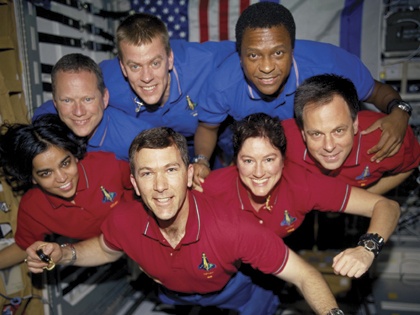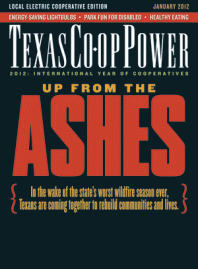The East Texas county of Sabine and town of Hemphill will never forget February 1, 2003. What began as a mild and sunny winter morning turned into a catastrophe that started with a horrific fireball in the sky and ended with unspeakable sorrow.
It was the day that NASA’s space shuttle Columbia, upon re-entry into Earth’s atmosphere after a 16-day science mission, disintegrated, killing the seven astronauts onboard. Ultimately, about 25,000 searchers recovered more than 84,000 pieces of debris—accounting for about 40 percent of the shuttle—that were scattered over thousands of acres of Louisiana and East Texas, including Sabine National Forest.
But early on, it was Sabine County that stepped up: More than 10,000 residents, including many from Hemphill, offered to assist with NASA’s recovery efforts, which included the grim task of finding the astronauts’ remains. During the weeks that followed, volunteers helped comb the dense forest and open fields on foot and horseback alongside local, state and national agency officials and media who came to town.
Their collective desire to memorialize the lives lost in the accident and the town’s response to the disaster came to fruition February 1, 2011, with the opening of the Patricia Huffman Smith Museum Remembering Columbia in Hemphill.
The idea for a museum evolved from the efforts of a group of citizens, including Sabine County Judge Jack Leath, now deceased; then-business owner Belinda Gay; and U.S. Forest Service employee Marsha Cooper, who helped organize annual memorial celebrations to honor the astronauts.
But the group wanted to do more. They formed the Sabine County Columbia Memorial Committee with the goal of building a permanent tribute, a museum.
Cooper recalls a most poignant time during the search: “Our main objective was to recover the astronauts’ remains,” she said. “We knew the first day we had all seven astronauts here, but kept it from the media to protect the families.”
After the remains were recovered, nearly 1,200 people attended a memorial service in town. “The service was a time for us to sit down and think about why this tragedy had happened to us,” Cooper said. “Then we came to realize there was no place on God’s green earth better than here. This is where they came to rest.”
But a museum memorializing that resting place would cost money the group didn’t have.
Enter Houston real-estate executive Albert Smith, whose wife, Patricia Huffman Smith, died in January 2010. The couple had donated money and all the land for the J.R. Huffman Public Library, named for Patricia’s father, which opened in 1994 in Hemphill.
Smith wanted to do something in memory of his wife. So in April, he donated the money for a museum to be built adjacent to the library. The following winter, on the eighth anniversary of the Columbia tragedy, the 3,400-square-foot museum held its grand opening.
At the front of the museum stands a replica of the Columbia, one-fifteenth the size of the actual spacecraft and designed to look as if it’s being propelled skyward. Just outside the entrance is a slab of Sabine County limestone inscribed with the opening of a Bible passage, Joshua 1:6-9, that Commander Rick Husband recited to the crew before liftoff: “Be strong and of a good courage …”
Inside, displays tell the story of space travel through photographs and objects, such as flight manuals and logs, freeze-dried food and a NASA space suit. Columbia completed 28 missions after its first launch on April 12, 1981.
One section of the museum is dedicated to the shuttle program itself, and a classroom contains books and interactive exhibits where visitors can learn about Columbia and its role in the overall goals of U.S. space exploration. In the works is an IMAX-style theater featuring NASA and National Geographic space-related videos.
Another area of the museum is devoted to showcasing local residents’ remarkable contributions to the recovery efforts, undertaken in the midst of deep personal sadness and a state of national mourning.
And, finally, there is a collection of 7-foot-tall glass display cases with personal items from each of the astronauts who lost their lives on that February morning: Commander Rick Husband; Pilot William McCool; Payload Commander Michael Anderson; Mission Specialists David Brown, Kalpana Chawla and Laurel Clark; and Payload Specialist Ilan Ramon, Israel’s first astronaut.
One case contains mementos from two men—pilot Jules “Buzz” Mier Jr. of Arizona and Charles Krenek, a debris search aviation specialist with the Texas Forest Service— who were killed in a helicopter crash during a search-and-recovery mission.
Flanked by an American flag and a flag representing each individual’s branch of service, the cases hold objects once a part of each astronaut’s life: a contact-lens case, military ID tags, a native dress from India, a pair of running shoes, a diary with Hebrew entries, family photos and a pair of Porsche racing gloves—the personal effects of those whose spirits found their rest in Hemphill.
——————–
Freelance writer Mark Miller lives in Flower Mound.
Museum hours: Monday through Saturday, 10 a.m.-5 p.m.; and Sunday, 1-5 p.m.; Patricia Huffman Smith Museum Remembering Columbia


